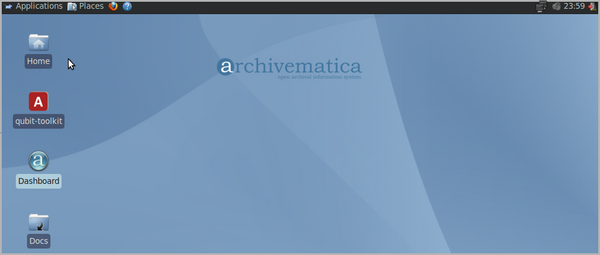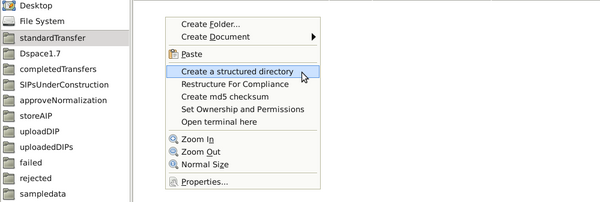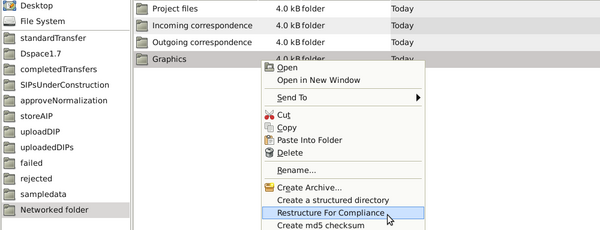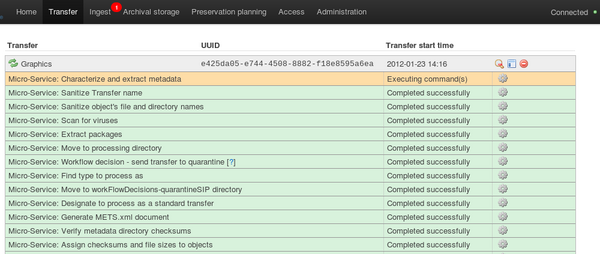Difference between revisions of "UM transfer"
| Line 6: | Line 6: | ||
== General description == | == General description == | ||
| − | During transfer, digital objects are moved into Archivematica and run through several micro-services: UUID assignment; checksum verification (if checksums are present); package extraction (i.e. unzipping of zipped or otherwise packaged files); virus checking; format identification and validation; and metadata extraction. </br> | + | For a definition of "transfer", please see the [[UM glossary|Glossary]]. During transfer, digital objects are moved into Archivematica and run through several micro-services: UUID assignment; checksum verification (if checksums are present); package extraction (i.e. unzipping of zipped or otherwise packaged files); virus checking; format identification and validation; and metadata extraction. </br> |
At the end of transfer, the user can select a number of ways to create one or more SIPs from the transfer. Once this is done, the SIP(s) are moved into ingest. | At the end of transfer, the user can select a number of ways to create one or more SIPs from the transfer. Once this is done, the SIP(s) are moved into ingest. | ||
Revision as of 20:38, 31 January 2012
Main Page > Documentation > User manual > User manual 0.8 > Transfer
General description
For a definition of "transfer", please see the Glossary. During transfer, digital objects are moved into Archivematica and run through several micro-services: UUID assignment; checksum verification (if checksums are present); package extraction (i.e. unzipping of zipped or otherwise packaged files); virus checking; format identification and validation; and metadata extraction.
At the end of transfer, the user can select a number of ways to create one or more SIPs from the transfer. Once this is done, the SIP(s) are moved into ingest.
Create a transfer
- Open the file browser by clicking on the Home folder on the Archivematica desktop (figure 1).
Option 1
Use this option if you have not yet compiled your objects and/or directories into a folder ready for processing.
- Navigate to the standardTransfer directory by using the shortcut on the left panel of the file manager.
- Hover your cursor over the empty right-hand panel, right-click and select "Create a structured directory" (figure 2).
- The structured directory will contain three subdirectories: logs, metadata, objects. Copy the digital files to be preserved into the objects directory. Note that you can create subdirectories within objects if desired.
Option 2
Use this option if you have already compiled your objects and/or directories into a folder ready for processing.
- Navigate to a directory of files to be preserved that has not been created using the right-click script in option 1, above.
- Right-click the directory and select "Restructure for compliance" (figure 3). This will create a structured directory containing the subdirectories required to transfer the files into Archivematica: logs, metadata, objects.
- Copy and paste the directory to standardTransfer using the shortcut on the left panel of the file manager.
Add submission documentation
In the transfer you have just created, navigate to the /metadata/submissionDocumentation folder and add files if desired. These files could be donor agreements, transfer forms, copyright agreements and any correspondence or other documentation relating to the transfer. Any SIPs subsequently made from this transfer will automatically contain copies of this documentation.
Process the transfer
- Open the Archivematica dashboard by clicking on the Dashboard icon in the Archivematica desktop (figure 1).
- Click on the transfer tab.
- The transfer will appear in the dashboard with a bell icon next to it. This means that it is awaiting a decision by the user.
- Hover your cursor over the transfer. This will bring up three icons on the right-hand side (figure 4).
- Click on the spyglass icon (figure 4).
- In the Actions drop-down menu, select "Transfer complete" to begin processing the transfer (figure 5).
- The transfer will now run through a series of micro-services. These include:
- Verify transfer compliance (verifies that the transfer is properly structured - i.e. with the logs, metadata and objects folders)
- Create transfer UUID (assigns a unique universal identifier for the transfer as a whole)
- Assign file UUIDs to objects (assigns a unique universal identifier to each file in the /objects directory)
- Verify metadata directory checksums (verifies any checksums included with the transfer)
- Assign checksums to objects (assigns a sha-256 checksum to each file in the /objects directory)
- Generate METS.xml document (creates a METS file capturing the original order of the transfer. This METS file is added to any SIPs generated from this transfer)
- Extract packages (extracts contents from zipped or otherwise packaged files)
- Sanitize object's file and directory names (removes prohibited characters from folder and filenames, such as ampersands)
- Scan for viruses (scans for viruses and malware)
- Characterize and extract metadata (identifies and validates file formats; extracts technical metadata embedded in the files)
- A transfer that is in the middle of processing will show which micro-services have been completed (green) and which are in progress (orange) (figure 6).
- Once the transfer micro-services are completed, a bell icon will appear next to the transfer. This means that the transfer is ready to be packaged into one or more SIPs (figure 7). See Ingest for next steps.






